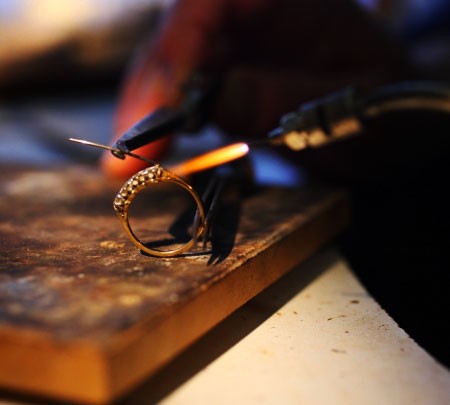While a diamond captures the light, it is the metal that holds the memory. The foundation you choose for your ring is more than just a technical specification; it is the canvas for your love story and a vessel for your legacy. At Diamond Studio NZ, we believe every bespoke piece should be built on a foundation as enduring as your commitment. Explore our guide to the noble metals we use in our studio, and find the perfect element to carry your story for a lifetime.
Ready to bring your vision to life? Book your private design consultation at our Mairangi Bay studio. Simply select a date that suits you, and let’s begin crafting your story together.
Noble Metals
The three precious metals often used in jewellery are gold, platinum, and silver. These precious metals are also known as noble metals. Any metal that resists corrosion and tarnishing is known as a noble metal. These metals also share the quality of durability, which means they are practical for use in jewellery because they stand up to knocks and bangs.
A mixture of two or more metals is known as an alloy. Precious metals used in jewellery are alloyed for three main reasons:
1. To change their properties and make them more workable and more durable
2. To alter or improve their appearance
3. To reduce the cost of jewellery
Even though gold, platinum, and silver all have superior qualities, each still needs to be alloyed to better suit different jewellery uses. The alloying of a precious metal for aesthetic reasons (the second reason listed above) applies primarily to gold, which is often alloyed to produce a range of colours. Platinum and silver are usually alloyed so that they can retain their original appearance. The third reason for alloying relates to keeping the cost down. Less precious metal is used in alloyed precious metals, and this reduces the final cost of jewellery.
Gold

The most desirable quality of gold is its ability to resist corrosion and tarnishing (a mild form of corrosion), an attribute that also makes gold a practical choice for high-quality jewellery. The Ancient Sumerians and Egyptians worked with gold as early as 3000 B.C., twisting, bending and pounding the precious metal into jewellery. They were able to make jewellery because gold is a malleable metal and can be stretched in all directions without breaking. Gold’s malleability makes it a versatile metal for jewellery. Gold also possesses beautiful lustre. The appearance of a material’s surface in reflected light is known as lustre. Gold’s ability to reflect light is one of its most important qualities. Below is a chart of karat gold measurements and their equivalents.
| Karat gold only) | 9k | 14k | 18k | 24K |
| Percentage of precious metal | 37.5% | 58.3% | 75% | 99.99% |
| Parts per thousand | 375 | 583 | 750 | 999 |
| Verbal equivalent (as ratios) | 9 parts gold to 15 parts other metals by weight | 14 parts gold to 10 parts other metal by weight | 18 parts gold to 6 parts other metals by weight | 24 parts gold |
Karats and their Equivalents
24k = 99.99% gold – Too soft for jewellery
22k = 91.7% gold – Very soft for jewellery
18k = 75% gold – Used for fine jewellery
14k = 58.3% gold – Used for jewellery
9k = 37.5% gold – The minimum percentage (or karat age) that is necessary for an item to be called gold jewellery in NZ.
Metal alloys for different colours of gold
14k Yellow- Gold, copper, silver, zinc
18k Yellow- Gold, copper, silver, zinc
Rose (pink)- Gold, copper, silver (amount of copper increased)
White- Gold, nickel or palladium, copper, zinc
White gold is plated with rhodium to enhance its whiteness.
Platinum

Compared to gold and silver, platinum is a relatively recent discovery. Europeans first learned of platinum when the Spanish discovered the metal during their occupation of Ecuador in the late 16th century. But it took two more centuries before European scientists learned how to work with what was at the time a mysterious new metal. Today, platinum is considered to be one of the strongest and most durable of all metals, and its melting point is very high, approximately 3224 degrees Fahrenheit (or 1773 degrees Celsius). Pure platinum is alloyed with other platinum group metals, mainly ruthenium or iridium. Mixing platinum with different members of its metals group creates new alloys that can be harder than platinum alone.
Platinum is naturally white in colour and does not wear down as gold does. It is also the heaviest of the precious metals used in jewellery. A 15 centimeter cube of platinum weighs 76.66 kg, about as much as an adult man. Platinum glimmers alluringly in the light, serving as a perfect backdrop for the glow of diamonds, pearls, and coloured gemstones. Polished platinum’s lustre can change over time, often producing a softer and richer glow as it ages. This glow is known as its “patina.”Unlike white gold, platinum is hypoallergenic and does not contain any nickel, making it a great precious metal to choose for individuals who have sensitive skin.
Silver

Silver is resistant to many substances, but it tarnishes slowly over time when exposed to sulphur compounds found in the air. Silver shines more brightly than any other metal on earth. It reflects more than 90 percent of visible light back to the eyes of the person viewing it. Its intense lustre and white colour combine to complement the wearer, making it ideal for jewellery. Of the three precious metals, pure silver is the lightest in weight. It is one of the most popular metals for customers who crave the white-metal look at an affordable price.
Throughout history, gold has been mixed with other metals for various reasons, from improving its strength to changing its colour. Pure gold is too soft and scratches easily, which means that all gold jewellery wears over time. Therefore, alloying pure gold with harder metals such as silver, copper or nickel, results in a durable alloy and the creation of new hues – such as different shades of yellow. The closer to 24-karat gold an alloy is, the more intense its yellow colour. Karat measures gold’s purity. The abbreviation for karat is k. Karat is expressed in 24ths, meaning that 18-karat gold consists of 75% pure gold and 25% other metal(s).



